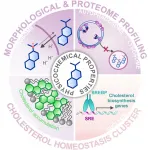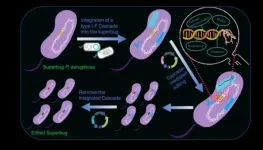Parkinson's disease: How lysosomes become a hub for the propagation of the pathology
2021-07-22
(Press-News.org) Over the last few decades, neurodegenerative diseases became one of the top 10 global causes of death. Researchers worldwide are making a strong effort to understand neurodegenerative diseases pathogenesis, which is essential to develop efficient treatments against these incurable diseases. However, our knowledge about the basic molecular mechanisms underlying the pathogenesis of neurodegenerative diseases is still lacking. A team of researchers found out the implication of lysosomes in the spread of Parkinson's disease.
The accumulation of misfolded protein aggregates in affected brain regions is a common hallmark shared by several neurodegenerative diseases (NDs). Mounting evidence in cellular and in animal models highlights the capability of different misfolded proteins to be transmitted and to induce the aggregation of their endogenous counterparts, this process is called "seeding". In Parkinson's disease, the second most common ND, misfolded α-synuclein (α-syn) proteins accumulate in fibrillar aggregates within neurons. Those accumulations are named Lewy bodies.
α-syn fibrils spreads through TNTs inside lysosomes
In 2016, a team of researchers from the Institut Pasteur (Paris) and the French National Centre for Scientific Research (in French: CNRS, Centre national de la recherche scientifique) demonstrated that α- syn fibrils spread from donor to acceptor cells through tunneling nanotubes (TNTs). They also found out that these fibrils are transferred through TNTs inside lysosomes. "TNTs are actin-based membrane channels allowing the transfer of several cellular components including organelles between distant cells. Lysosomes are organelles normally deputed to the degradation and recycling of toxic/damaged cell material" describes Chiara Zurzolo, head of the Membrane Traffic and Pathogenesis Unit at the Institut Pasteur.
α-syn fibrils can modify lysosome shape and permeability to allow seeding and diffusion
Following this original discovery, researchers, now shed some light on how lysosomes participate in the spreading of α-syn aggregates through TNTs. "By using super-resolution and electron microscopy, we found that α-syn fibrils affect the morphology of lysosomes and impair their function in neuronal cells. We demonstrated for the first time that α-syn fibrils induce the peripheral redistribution of the lysosomes thus increasing the efficiency of α-syn fibrils' transfer to neighbouring cells," continues Chiara Zurzolo. They also showed that α-syn fibrils can permeabilize the lysosomal membrane, impairing the degradative function of lysosomes and allowing the seeding of soluble α-syn, which occurs mainly in those lysosomes. Thus, by impairing lysosomal function α-syn fibrils block their own degradation in lysosomes, that instead become a hub for the propagation of the pathology.
BY IMPAIRING LYSOSOMAL FUNCTION Α-SYN FIBRILS BLOCK THEIR OWN DEGRADATION IN LYSOSOMES, THAT INSTEAD BECOME A HUB FOR THE PROPAGATION OF THE PATHOLOGY
This discovery contributes to the elucidation of the mechanism by which α-syn fibrils spread through TNTs, while also revealing the crucial role of lysosomes, working as a Trojan horse for both seeding and propagation of disease pathology. This information can be exploited to establish novel therapies to target these incurable diseases.
INFORMATION:
ELSE PRESS RELEASES FROM THIS DATE:
2021-07-22
Artificial intelligence tools and deep learning models are a powerful tool in cancer treatment. They can be used to analyze digital images of tumor biopsy samples, helping physicians quickly classify the type of cancer, predict prognosis and guide a course of treatment for the patient. However, unless these algorithms are properly calibrated, they can sometimes make inaccurate or biased predictions.
A new study led by researchers from the University of Chicago shows that deep learning models trained on large sets of cancer genetic and tissue histology data can easily identify the institution that submitted the images. The models, which use machine learning methods to "teach" themselves how to recognize certain cancer signatures, ...
2021-07-22
Replication of SARS-CoV-2, the virus responsible for COVID-19, depends on a series of interactions between viral proteins and different cellular partners such as nucleic acids (DNA or RNA). Characterizing these interactions is crucial to elucidate the process of viral replication and identify new drugs for treating COVID-19.
An interdisciplinary consortium of scientists from the Institut Pasteur, the Ecole Polytechnique, the Institut Curie, Inserm, the CNRS and the universities of Paris, Paris-Saclay, Bordeaux and Toulouse have demonstrated a specific interaction between a domain of a SARS-CoV-2 protein (Nsp3) and ...
2021-07-22
When Alexander Flemming discovered a mould on a culture plate overgrown with bacteria in 1928, he did not expect to find one of the most widely used active substances: penicillin. Accidental discoveries and the identification of active ingredients from traditional remedies, such as the morphine of the opium poppy, have shaped the discovery of new medicines for a long time.
Modern drug discovery - from chance to system
Meanwhile, major developments in chemistry and molecular biology have been made that enable a systematic and targeted search for potential active substances in modern drug discovery. First, advances in the field of organic and ...
2021-07-22
TROY, N.Y. -- An innovative testing platform that more closely mimics what cancer encounters in the body may allow for more precise, personalized therapies by enabling the rapid study of multiple therapeutic combinations against tumor cells. The platform, which uses a three-dimensional environment to more closely mirror a tumor microenvironment, is demonstrated in research published in Communications Biology.
"This whole platform really gives us a way to optimize personalized immunotherapy on a rapid, high throughput scale," said Jonathan Dordick, Institute Professor of chemical and biological engineering and member of the Center for Biotechnology and Interdisciplinary Studies (CBIS) at Rensselaer Polytechnic Institute, ...
2021-07-22
It's a favourite first-order for the day, but while a quick coffee may perk us up, new research from the University of South Australia shows that too much could be dragging us down, especially when it comes to brain health.
In the largest study of its kind, researchers have found that high coffee consumption is associated with smaller total brain volumes and an increased risk of dementia.
Conducted at UniSA's Australian Centre for Precision Health at SAHMRI and a team of international researchers*, the study assessed the effects of coffee on the brain among 17,702 UK Biobank participants (aged 37-73), finding that those who drank more than six cups of coffee a day had a 53 per cent increased risk of dementia.
Lead researcher and UniSA PhD candidate, ...
2021-07-22
Silicon, a semi-metal, bonds in its natural form with four other elements and its three-dimensional structure takes the form of a tetrahedron. For a long time, it seemed impossible to achieve the synthesis and characterisation of a two-dimensional equivalent - geometrically speaking, a square. Now scientists from the field of Inorganic Chemistry at Heidelberg University have succeeded in producing a crystalline complex with such a configuration. PD Dr Lutz Greb from the Institute of Inorganic Chemistry underlines that it has surprising physical and chemical properties and, in the field of molecular chemistry, will open up new approaches to using the second most abundant element in the Earth's crust for catalysis and materials research.
As a classical ...
2021-07-22
The touchscreen technology used in billions of smartphones and tablets could also be used as a powerful sensor, without the need for any modifications.
Researchers from the University of Cambridge have demonstrated how a typical touchscreen could be used to identify common ionic contaminants in soil or drinking water by dropping liquid samples on the screen, the first time this has been achieved. The sensitivity of the touchscreen sensor is comparable to typical lab-based equipment, which would make it useful in low-resource settings.
The researchers say their proof of concept could one day be expanded for a wide range of sensing applications, including for biosensing or medical diagnostics, right from the phone in your pocket. The results are reported ...
2021-07-22
Many applications, from fiber-optic telecommunications to biomedical imaging processes require substances that emit light in the near-infrared range (NIR). A research team in Switzerland has now developed the first chromium complex that emits light in the coveted, longer wavelength NIR-II range. In the journal Angewandte Chemie, the team has introduced the underlying concept: a drastic change in the electronic structure of the chromium caused by the specially tailored ligands that envelop it.
Many materials that emit NIR light are based on expensive or rare metal complexes. Cheaper alternatives that emit in the NIR-I range between 700 and 950 nm have been developed but NIR-II-emitting complexes of non-precious metals remain extremely rare. Luminescence in the NIR-II range (1000 to 1700 ...
2021-07-22
A research team led by Wim Annaert (VIB-KU Leuven) uncovered the early assembly of gamma-secretase, a protein complex linked to numerous cellular processes including the development of Alzheimer's disease. In a first step, two dimeric subcomplexes are formed, which independently exit the ER and only afterwards assemble into a four-subunit complex. This 'buckle up' mechanism is thought to prevent premature assembly and activity. The new insights are very relevant, as gamma-secretase is an important potential therapeutic target for Alzheimer's and other ...
2021-07-22
A research team led by Dr Aixin YAN, Associate Professor from the Research Division for Molecular & Cell Biology, Faculty of Science, in collaboration with Honorary Clinical Professor Patrick CY WOO from the Department of Microbiology, Li Ka Shing Faculty of Medicine, the University of Hong Kong (HKU), reported the development of a transferrable and integrative type I CRISPR-based platform that can efficiently edit the diverse clinical isolates of Pseudomonas aeruginosa, a superbug capable of infecting various tissues and organs and a major source of nosocomial infections. The ...
LAST 30 PRESS RELEASES:
[Press-News.org] Parkinson's disease: How lysosomes become a hub for the propagation of the pathology

